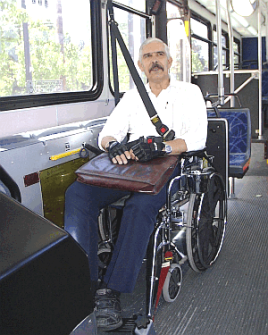ADA Paratransit Eligibility
Paratransit Eligibility
There are 3 categories of eligibility, found in the Code of Federal Regulations -ADA Paratransit Eligibility Standards (49 CAVER 37.123 (e)(1-3)):
1."An individual with a disability who is unable, as the result of a physical or mental impairment (including a vision impairment), and without the assistance of another individual (except the operator of a wheelchair lift or other boarding assistance device), to board, ride, or disembark from any vehicle on the system which is readily accessible to and usable by individuals with disabilities."
2."An individual with a disability who needs the assistance of a wheelchair lift or other boarding assistance device and is able, with such assistance, to board, ride, and disembark from any vehicle which is readily accessible to and usable by individuals with disabilities if the individual wants to travel on a route on the system during the hours of operation of the system at a time, or within a reasonable period of such time, when such a vehicle is not being used to provide designated public transportation on the route."
3."An individual with a disability who has a specific impairment-related condition which prevents such individual from traveling to a boarding location or from a disembarking location on such system."
Two important qualifiers
1.Environmental conditions and architectural barriers not under the control of the public entity do not, when considered alone, confer eligibility. If, however, travel to or from a boarding location is prevented when these factors are combined with the person's specific impairment-related condition, paratransit service must be provided. Examples are snow and/or ice, extremes in temperature (hot or cold), or temporary construction projects.
2.The specific impairment-related condition must prevent the person from using the fixed route system. Conditions which make getting to or from stops/stations more difficult do not confer eligibility. A determination of whether travel is difficult rather than "prevented" will need to be made. Appendix D of the regulations offers the following guidance to clarify the concepts of "prevented" travel and the relationship between architectural and environmental conditions
and a person's disability.
"For anyone, going to a bus stop and waiting for a bus is more difficult and less comfortable than waiting for a vehicle at one's home. This is likely to be all the more true for an individual with a disability. But for many persons with disabilities, in many circumstances, getting to a bus stop is possible. If an impairment related condition only makes the job of accessing transit more difficult than it might otherwise be, then the person is not eligible." [Appendix D, Section 37.123 Category 3 Eligibility]
If you think you are eligible, complete and mail an ADA paratransit application.
